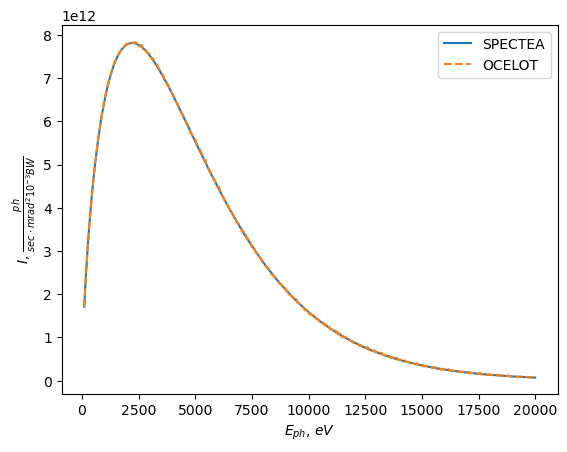This notebook was created by Sergey Tomin (sergey.tomin@desy.de). June 2019.
1. Synchrotron Radiation Module
Synchrotron radiation module is also included to the OCELOT multiphysics simulation toolkit .
The OCELOT SR module is capable of calculating spectrum and spatial distribution of spontaneous radiation from a single electron in a magnetic field defined by file data (field on an insertion device axis or 3D magnetic field map) or using standard elements as Undulator with arbitrary defined period, length and .
Some details about SR module can be found in S. Tomin, G. Geloni, Synchrotron Radiation Module in OCELOT Toolkit
Contents
Ideal magnetic field
To estimate SR from undulator you can use ideal sinus like magnetic field with . In that case, we can use Undulator element with standard parameters like , period length, number of periods.
# To activate interactive matplolib in notebook
#%matplotlib notebook
# import main functions from Synchrotron Radation (SR) module
from ocelot.rad import *
# import OCELOT main functions
from ocelot import *
# import OCELOT plotting functions
from ocelot.gui import *
import time
initializing ocelot...
As usual we start from creating elements and lattice.
At the moment SR module recognize only Undulator element. Even if you want to calculate radiation from dipole magnet.
und = Undulator(Kx=0.43, nperiods=500, lperiod=0.007, eid="und")
lat = MagneticLattice((und))
To calculate radiation one needs two additional objects
Beam()to provide the electron beam energy and beam current.
The earlier version of SR solver could calculate emittance and energy spread effect. In current version, we focus on single electron radiation. Although, these effects can be added to subsequent releases.
Screen()class to store radiation field and to provide information about screen parameters where radiation will be observed.
Spatial distribution
To calculate spatial distribution we need to define screen size(s) and number of points in each planes. We start with simplest 1D case.
beam = Beam()
beam.E = 2.5 # beam energy in [GeV]
beam.I = 0.1 # beam current in [A]
screen = Screen()
screen.z = 100.0 # distance from the begining of lattice to the screen
screen.size_x = 0.002 # half of screen size in [m] in horizontal plane
screen.size_y = 0. # half of screen size in [m] in vertical plane
screen.nx = 101 # number of points in horizontal plane
screen.ny = 1 # number of points in vertical plane
screen.start_energy = 7761.2 # [eV], starting photon energy
screen.end_energy = 7900 # [eV], ending photon energy
screen.num_energy = 1 # number of energy points[eV]
Calculate SR
to calculate SR from one electron there is a function:
screen = calculate_radiation(lat, screen, beam)
lat: MagneticLattice should include element Undulatorscreen: Screen classbeam: Beam class, the radiation is calculated from one electron
Optional parameters:
energy_loss: False, if True includes energy loss after each periodquantum_diff: False, if True introduces random energy kickaccuracy: 1, scale for trajectory points numberend_poles: False, if True includes end poles with 1/4, -3/4, 1, ...
start = time.time()
screen = calculate_radiation(lat, screen, beam)
print("time exec: ", time.time() - start, " sec")
time exec: 2.759495973587036 sec
Electric field is stored in 1D arrays
screen.arReEx: array, Real part of horizontal component of the electric fieldscreen.arImEx: array, Imaginary part of horizontal component of the electric fieldscreen.arReEy: array, Real part of the vertical component of the electric fieldscreen.arImEy: array, Imaginary part of the vertical component of the electric fieldscreen.arPhase: array, phase between Re and Im components
Also, Screen has coordinates where radiation was calculated
screen.Xph, 1D array with coordinates in horizontal planescreen.Yph, 1D array with coordinates in vertical planescreen.Eph, 1D array with coordinates in energetic plane
Photon flux is calculated from the electric field and stored in 1D arrays:
screen.Sigma: horizontal polarization component inscreen.Pi: vertical polarization component inscreen.Total = screen.Sigma + screen.Pi: total flux density in
plt.figure(10)
plt.plot(screen.Xph, screen.Total)
plt.ylabel(r"F, $\frac{ph}{sec \cdot mm^2 10^{-3}BW}$")
plt.xlabel(r"X [mm]")
plt.show()
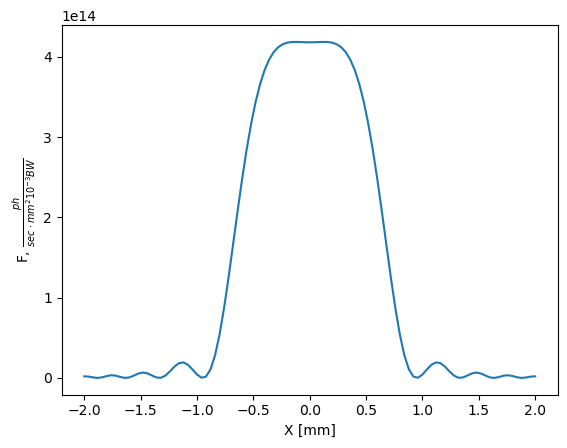
Plotting utils
you can use standard plotting function
show_flux(screen, unit="mm")
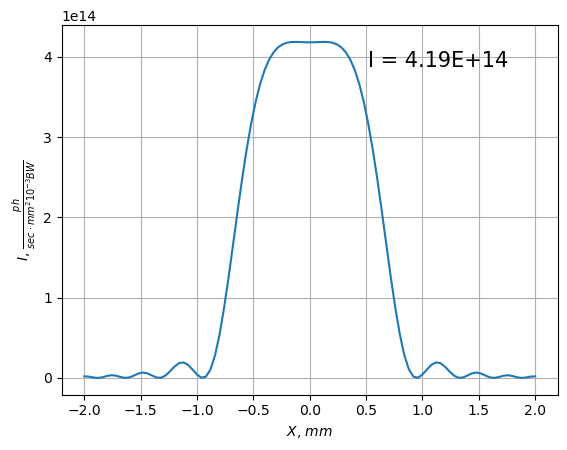
in [mrad]
show_flux(screen, unit="mrad", nfig=2)
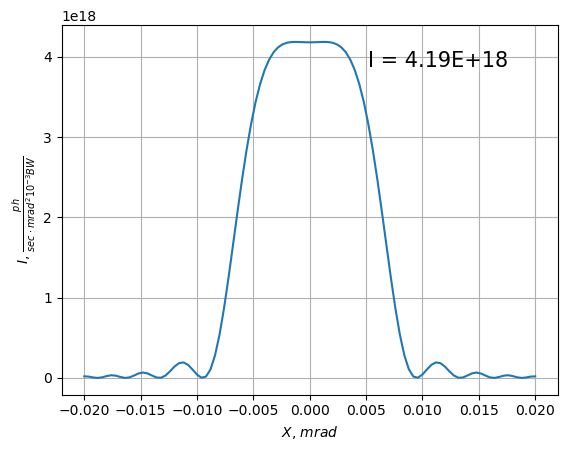
Phase
Relation between the time at the observer and the time of emission
where
where
is the electron trajectory,
Using assumptions:
we finally get
During calculation of the radiation we assume .
At the last step in the function calculate_radiation method screen.add_fast_oscilating_term(x0=0, y0=0, z0=0) is called which adds the subtracted term.
plt.figure(1000)
plt.plot(screen.Xph, screen.arPhase)
plt.xlabel("x [mm]")
plt.ylabel("Phase")
plt.show()
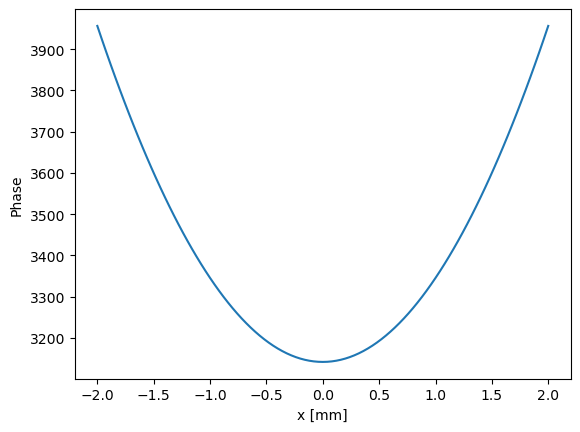
Spectrum
The same way to calculate on-axis spectrum
beam = Beam()
beam.E = 2.5 # beam energy in [GeV]
beam.I = 0.1 # beam current in [A]
screen = Screen()
screen.z = 100.0 # distance from the begining of lattice to the screen
screen.start_energy = 7600 # [eV], starting photon energy
screen.end_energy = 7900 # [eV], ending photon energy
screen.num_energy = 1000 # number of energy points[eV]
# Calculate radiation
start = time.time()
screen = calculate_radiation(lat, screen, beam)
print("time exec: ", time.time() - start, " sec")
# show result
show_flux(screen, unit="mrad", nfig=12)
time exec: 0.5590729713439941 sec
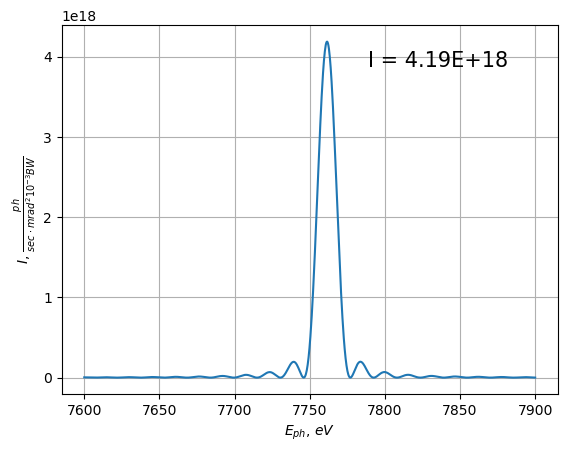
2D spatial distribution
beam = Beam()
beam.E = 2.5 # beam energy in [GeV]
beam.I = 0.1 # beam current in [A]
screen = Screen()
screen.z = 100.0 # distance from the begining of lattice to the screen
screen.size_x = 0.002 # half of screen size in [m] in horizontal plane
screen.size_y = 0.002 # half of screen size in [m] in vertical plane
screen.nx = 51 # number of points in horizontal plane
screen.ny = 51 # number of points in vertical plane
screen.start_energy = 7761.2 # [eV], starting photon energy
screen.end_energy = 7900 # [eV], ending photon energy
screen.num_energy = 1 # number of energy points[eV]
start = time.time()
# Calculate radiation
screen = calculate_radiation(lat, screen, beam)
print("time exec: ", time.time() - start, " sec")
# show result
show_flux(screen, unit="mrad", nfig=13)
time exec: 1.052764892578125 sec
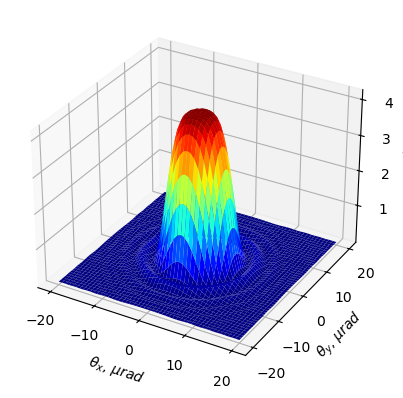
3D distribution in arbitrary domains
see tutorial PFS tutorial N4. Converting synchrotron radiation results from Screen object to RadiationField
Magnetic Field map on the undulator axis
At the moment, spatial coordinates must be in [mm]. Field map can have 3 formats:
- Planar undulator. 2 columns in the file. The first column is longitudinal coordinates in [mm] and second the vertical magnetic field in [T]. [Z, By]
- Spiral undulator. 3 columns in the file. The first column is longitudinal coordinates in [mm] and second the horizontal magnetic field and vertical in [T]. [Z, Bx, By]
- 3D magnetic field. [x, y, z, Bx, By, Bz]
Planar undulator.
First off we will generate magnetic field.
lperiod = 0.04 # [m] undulator period
nperiods = 30 # number of periods
B0 = 1 # [T] amplitude of the magnetic field
# longitudinal coordinates from 0 to lperiod*nperiods in [mm]
z = np.linspace(0, lperiod*nperiods, num=500)*1000 # [mm]
lperiod_mm = lperiod * 1000 # in [mm]
By = B0*np.cos(2*np.pi/lperiod_mm*z)
plt.figure(100)
plt.plot(z, By)
plt.xlabel("z [mm]")
plt.ylabel("By [T]")
plt.show()
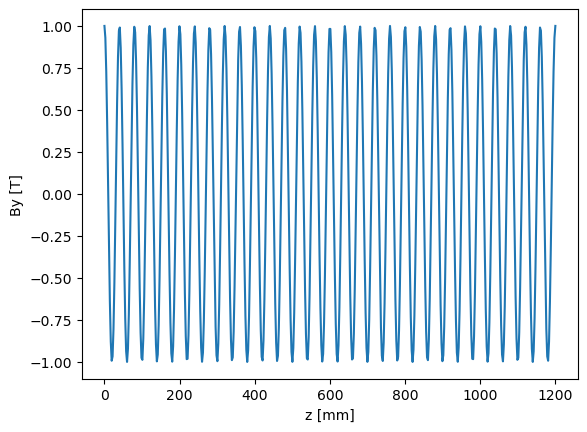
Save the map into a file
filed_map = np.vstack((z, By)).T
np.savetxt("filed_map.txt", filed_map)
Create undulator element with field map and initialize MagneticLattice
und_m = Undulator(field_file="filed_map.txt", eid="und")
lat_m = MagneticLattice((und_m))
beam = Beam()
beam.E = 17.5 # beam energy in [GeV]
beam.I = 0.1 # beam current in [A]
screen = Screen()
screen.z = 1000.0 # distance from the begining of lattice to the screen
screen.start_energy = 7000 # [eV], starting photon energy
screen.end_energy = 12000 # [eV], ending photon energy
screen.num_energy = 1000 # number of energy points[eV]
# Calculate radiation
screen = calculate_radiation(lat_m, screen, beam)
# show result
show_flux(screen, unit="mrad", nfig=103)

Estimation radiation properties
We can estimate radiation properties using function:
print_rad_props(beam, K, lu, L, distance)
beamis Beam classKis undulator parameterluis undulator period in [m]Lis undulator length in [m]distanceis distance to the screen in [m]
Also we have simple functions which can translate one undulator parameter to another, like:
field2K(field, lu=0.04)
K = field2K(field=B0, lu=lperiod)
print_rad_props(beam, K, lu=lperiod, L=lperiod*nperiods, distance=screen.z)
********* ph beam ***********
Ebeam : 17.5 GeV
K : 3.7349164279988596
B : 1.0 T
lambda : 1.35992E-10 m
Eph : 9.11702E+03 eV
1/gamma : 29.1999 um
sigma_r : 1.4376 um
sigma_r' : 7.5275 urad
Sigma_x : 1.4376 um
Sigma_y : 1.4376 um
Sigma_x' : 7.5275 urad
Sigma_y' : 7.5275 urad
H. spot size : 7.5275 / 0.0075 mm/mrad
V. spot size : 7.5275 / 0.0075 mm/mrad
I : 0.1 A
Nperiods : 30.0
distance : 1000.0 m
flux tot : 2.05E+14 ph/sec/0.1%BW
flux density : 5.76E+17 ph/sec/mrad^2/0.1%BW; 5.76E+11 ph/sec/mm^2/0.1%BW
brilliance : 4.44E+22 ph/sec/mrad^2/mm^2/0.1%BW
K = field2K(field=B0, lu=lperiod)
beam = Beam()
beam.E = 0.13
beam.I = 0.1
print_rad_props(beam, K=20, lu=0.2, L=lperiod*20, distance=100)
********* ph beam ***********
Ebeam : 0.13 GeV
K : 20
B : 1.071 T
lambda : 3.10563E-04 m
Eph : 3.99224E-03 eV
1/gamma : 3930.7605 um
sigma_r : 1773.8821 um
sigma_r' : 13932.0371 urad
Sigma_x : 1773.8821 um
Sigma_y : 1773.8821 um
Sigma_x' : 13932.0371 urad
Sigma_y' : 13932.0371 urad
H. spot size : 1393.2048 / 13.932 mm/mrad
V. spot size : 1393.2048 / 13.932 mm/mrad
I : 0.1 A
Nperiods : 4.0
distance : 100 m
flux tot : 2.77E+13 ph/sec/0.1%BW
flux density : 2.27E+10 ph/sec/mrad^2/0.1%BW; 2.27E+06 ph/sec/mm^2/0.1%BW
brilliance : 1.15E+09 ph/sec/mrad^2/mm^2/0.1%BW
Arbitrary magnetic field map - pythonic way
In OCELOT there is a way to define the 3D magnetic fields as a function.
Let's consider above example with field map in the file. But this time we will use another approach.
lperiod = 0.04 # [m] undulator period
nperiods = 30 # number of periods
B0 = 1 # [T] amplitude of the magnetic field
# longitudinal coordinates from 0 to lperiod*nperiods in [mm]
z = np.linspace(0, lperiod*nperiods, num=1000)*1000 # [mm]
By = B0*np.cos(2*np.pi/lperiod*z)
def py_mag_field(x, y, z, lperiod, B0):
"""
x, y, z = coordinates
"""
Bx = 0
By = B0*np.cos(2*np.pi/lperiod*z)
Bz = 0
return (Bx, By, Bz)
plt.figure(110)
plt.plot(z, py_mag_field(x=0, y=0, z=z, lperiod=lperiod, B0=B0)[1])
plt.xlabel("z [mm]")
plt.ylabel("By [T]")
plt.show()
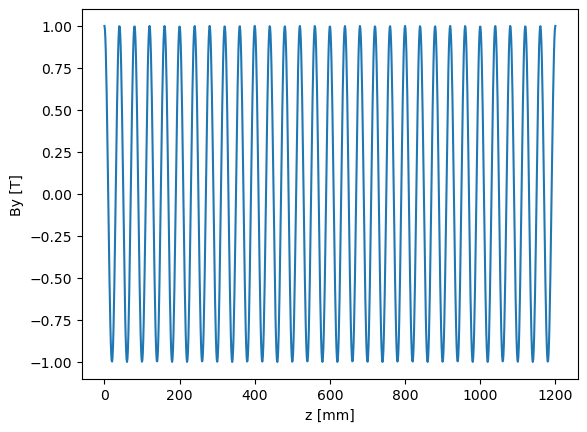
Attribute mag_field
Undulator element has the attribute mag_field , which takes on the function as follows:
(Bx, By, Bz) = f(x, y, z).
For example, we define only the vertical magnetic field and other components are zero:
field = lambda x, y, z: (0, cos(kz * z), 0)
In case, the attribute mag_field is a function, you still need to define lperiod and nperiods in the Undulator. It will allow to calculate the length of the undulator.
und_m = Undulator(lperiod=lperiod, nperiods=nperiods, Kx=0.0,eid="und")
und_m.mag_field = lambda x, y, z: py_mag_field(x, y, z, lperiod=lperiod, B0=B0)
# next, all the same.
lat_m = MagneticLattice((und_m))
beam = Beam()
beam.E = 17.5 # beam energy in [GeV]
beam.I = 0.1 # beam current in [A]
screen = Screen()
screen.z = 1000.0 # distance from the begining of lattice to the screen
screen.start_energy = 7000 # [eV], starting photon energy
screen.end_energy = 12000 # [eV], ending photon energy
screen.num_energy = 1000 # number of energy points[eV]
# Calculate radiation
screen = calculate_radiation(lat_m, screen, beam, accuracy=2)
# show result
show_flux(screen, unit="mrad", nfig=104)
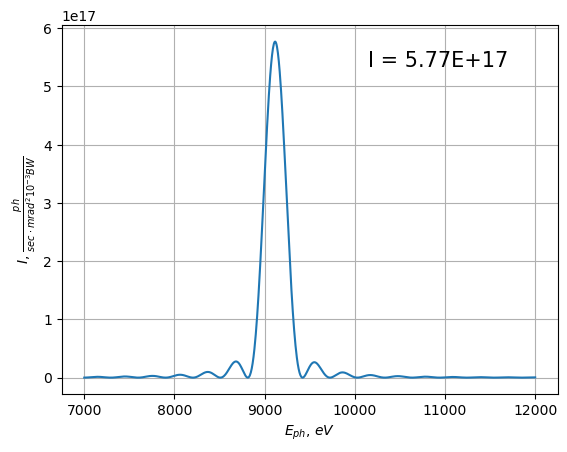
Accuracy and number of trajectory points
As it was pointed out above, the function calculate_radiation has argument accuracy=1 which scales number of trajectory points.
In the current version of ocelot (19.06) the number of points is calculated by simple expression:
n = int((undul_length*1500 + 100)*accuracy)
Trajectory
The object Screen after the radiation calculation contains the electron trajectory what was used in a special object BeamTraject which is attached to:
screen.beam_traj = BeamTraject()
To retrieve trajectory you need to specify number of electron what you are interested, for example:
x = screen.beam_traj.x(n=0)
for more details have a look to Tutorial #10 "Simple accelerator based THz source"
In case of calculate_radiation the BeamTraject contains only one trajectory, so n = 0
n = 0
x = screen.beam_traj.x(n)
y = screen.beam_traj.y(n)
z = screen.beam_traj.z(n)
plt.title("trajectory of " + str(n)+"th particle")
plt.plot(z, x, label="X")
plt.plot(z, y, label="Y")
plt.xlabel("Z [m]")
plt.ylabel("X/Y [m]")
plt.legend()
plt.show()
print(f"Number of trajectory points n={len(z)}")
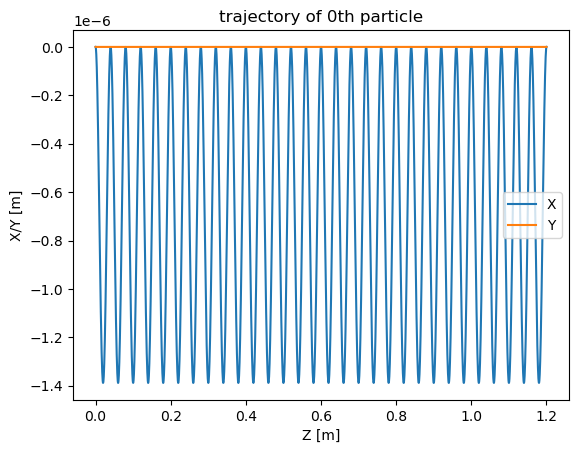
Number of trajectory points n=3800
Radiation from bendig magnet
OCELOT currently does not have a direct and simple method for calculating radiation from a dipole magnet. However, there is still a way, albeit with some annoying details which we will demostrate.
As was mentioned above, the Undulator element has a atribute mag_field which we will use to simulate magnetic field of a bending magnet.
Let's assume we have a bending magnet with T amplitude of magnetic field
By = 1. # T - amplitude of vertical magnetic field.
b = Undulator(lperiod=0.10, nperiods=10, eid="und")
b.mag_field = lambda x, y, z: (0, By, 0)
# in the Undulator element parameters lperiod and nperiods are needed
# just for definition of the length of the element
d = Drift(l=1)
lat_b = MagneticLattice((b,))
beam = Beam()
beam.E = 2 # beam energy in [GeV]
beam.I = 0.1 # beam current in [A]
screen = Screen()
screen.z = 1000.0 # distance from the begining of lattice to the screen
screen.start_energy = 100 # [eV], starting photon energy
screen.end_energy = 20000 # [eV], ending photon energy
screen.num_energy = 1000 # number of energy points[eV]
# Calculate radiation
start = time.time()
screen = calculate_radiation(lat_b, screen, beam, accuracy=5)
print("time exec: ", time.time() - start)
time exec: 0.9805309772491455
Display the electron trjectory
x = screen.beam_traj.x(0)
y = screen.beam_traj.y(0)
z = screen.beam_traj.z(0)
plt.title("trajectory of a particle")
plt.plot(z, x, label="X")
plt.plot(z, y, label="Y")
plt.xlabel("Z [m]")
plt.ylabel("X/Y [m]")
plt.legend()
plt.show()
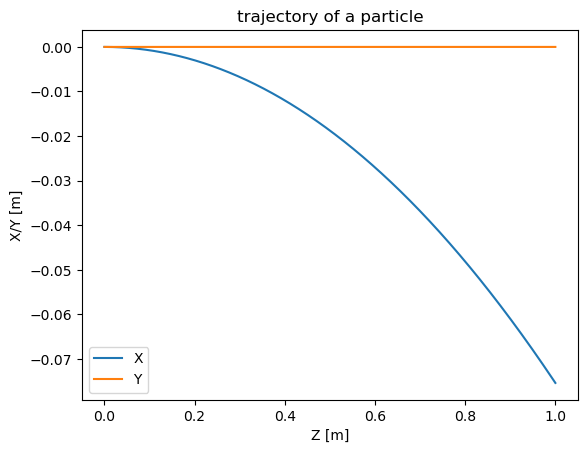
As we see, the electron has zero initial coordinates and moves along a circular path in the dipole. At the same time, we must remember that the point at which we observe the radiation has the coordinates (Screen.x, Screen.y, Screen.z) = (0, 0, 1000) m.
If one wants to calculate radiation from the bunch of electrons (with non trivial phase space distribution) from a bending magnet, one should remember two different coordinate systems for calculating the beam dynamics and calculating the radiation. Currently, a general recommendation is to track the beam to the bending magnet, and then caclualte the radiation. See details in Tutorial N9. Simple accelerator based THz source.
In order to observe radiation from the central part of the magnet we will modify initial coordinates of the electron beam. But first, find them.
# the beam momentum
p = np.sqrt(beam.E**2 - m_e_GeV**2)/speed_of_light
# radius of the trajectory in the bending magnet
R = p*1e9 /By
print("R = ", R, " m")
# angle of the bend
phi = np.arcsin(1 / R)
print("analitical silotion: phi = ", phi, " rad")
print("numerical solution: phi ", np.abs(screen.beam_traj.xp(0)[-1]), " rad")
# offset
x_off = R * (1 - np.cos(phi/2))
print("Offset in X direction: ", x_off, " m")
R = 6.671281686212527 m
analitical silotion: phi = 0.15046332005984778 rad
numerical solution: phi 0.151609149365928 rad
Offset in X direction: 0.018870166315482287 m
Recalculate radiation with new initial coordinates
beam = Beam()
beam.E = 2 # beam energy in [GeV]
beam.I = 0.1 # beam current in [A]
# set new initial coordinates for the beam
beam.xp = phi/2 # initial angle x'
beam.x = -x_off # initial offset
screen = Screen()
screen.z = 1000.0 # distance from the begining of lattice to the screen
screen.start_energy = 100 # [eV], starting photon energy
screen.end_energy = 20000 # [eV], ending photon energy
screen.num_energy = 500 # number of energy points[eV]
# Calculate radiation
start = time.time()
screen = calculate_radiation(lat_b, screen, beam, accuracy=6)
print("time exec: ", time.time() - start)
# display trajectory
x = screen.beam_traj.x(0)
y = screen.beam_traj.y(0)
z = screen.beam_traj.z(0)
plt.title("trajectory of a particle")
plt.plot(z, x, label="X")
plt.plot(z, y, label="Y")
plt.xlabel("Z [m]")
plt.ylabel("X/Y [m]")
plt.legend()
plt.show()
time exec: 0.7360131740570068
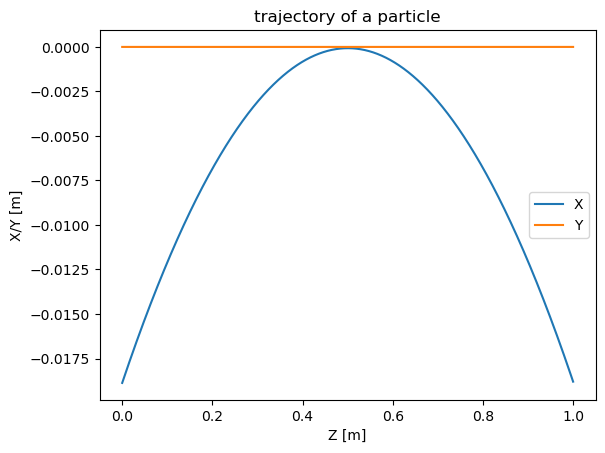
# show result
show_flux(screen, unit="mrad", nfig=204, xlog=False, ylog=False)
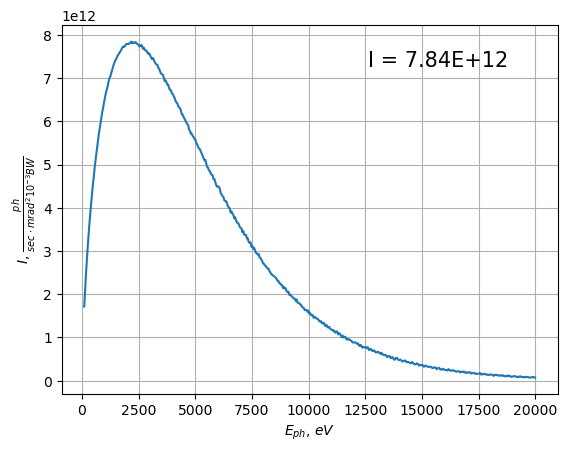
Show Flux density and compare the result with SPECTRA
The same setup was simulated with SPECTRA and saved in "bm_spectra.dc0"
# load SPECTRA result
a = np.loadtxt("bm_spectra.dc0", skiprows=2, usecols=[0, 1])
plt.plot(a[:,0], a[:,1], label="SPECTEA")
plt.plot(screen.Eph, screen.Total * screen.z**2, "--", label="OCELOT")
plt.ylabel(r"$I$, $\frac{ph}{sec \cdot mrad^2 10^{-3}BW}$")
plt.xlabel(r'$E_{ph}$, $eV$')
plt.legend()
plt.show()
